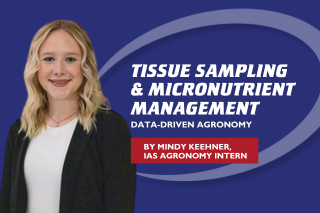Tissue Sampling & Micronutrient Management Data-Driven Agronomy

Written by: Mindy Keehner, IAS Agronomy Intern
From the outside, a plant may appear deficient in one thing, but from the inside standpoint, the same plant may be deficient in multiple nutrients, slipping right under the grower’s nose. Tissue sampling in crop production provides the grower with insight into how a plant is using nutrients during the growing season. It can help growers make mid-season decisions and furthermore gather long-term information on their crops’ needs. Tissue sampling will give results for the main nutrients; nitrogen, and sulfur, as well as many micronutrients such as iron, boron, manganese, and zinc. While soil sampling gets you comparable results, tissue sampling provides a mid-season snapshot for the current crop’s needs.
Timing tissue sampling is critical when it comes to accuracy of the results. Too early, and the crop may not have taken in the nutrients from the ground yet. Too late, and the crop will have distributed the nutrients throughout itself, and results will be lower. Always remember to diversify your sampling by taking samples from various parts of the field. The following are the most important things to consider when it comes to tissue sampling:
- Do not sample too early or too late into the growing season.
- Sample the correct part of the plant.
- Handle samples properly.
- Understand what the results can or cannot tell you.

Managing nutrient content in your fields is key to supporting a successful crop. Knowing what your land is missing can help you understand and better make decisions for your operation. Fertilizer applications can vary from foliar (during growing season) to dry applications (post-harvest). Each method has its pros and cons, and it is up to you to choose what is best for your crops.
After receiving your tissue sample results you think, “Well now what do I do? What method should I use? When should I apply fertilizer? What are my options?” When reading your results, it is important to recognize the limiting factor that may be hindering your potential yield goals. Tissue sample results will provide the actual concentration of the nutrient in your plant while also comparing it to a ‘normal’ or suggested amount that should be present. Collecting samples over many years will assist growers in recognizing deficiency patterns in their practices, and make them aware of how well plants are absorbing nutrients.


Growers may also choose to do a combination based on their land type, field history, and crops planted. Other factors may include timing of your application, soil conditions, type of fertilizer needed, and cost of products needed. Ultimately, choosing the appropriate method for your operation is the most important consideration. Be sure to be knowledgeable about your field and production habits to ensure successful fertilizer applications.
For questions about your tissue sample results or help determining the right nutrient application method for your fields, reach out to your local IAS agronomist. Our team is here to support your goals with data-driven recommendations and hands-on expertise. Don’t have a contact yet? Call or stop by your nearest Innovative Ag Services location — we’re ready to help you make the most of your crop’s potential.
__________________________________________________________________________________________
Resources:
https://www.winfieldunited.com/news-and-insights/why-you-should-be-tissuetesting#:~:text=Tissue%20testing%20gives%20your%20crop,strategic%20decisions%20year%20after%20year
https://www.winfieldunited.com/news-and-insights/use-tissue-sampling-data-to-drive-fertilizer-decisions
https://blog-crop-news.extension.umn.edu/2023/03/plant-tissue-analysis-what-to-know.html
https://blog-crop-news.extension.umn.edu/2024/05/5-things-to-consider-before-collecting.html
https://www.agritecint.com/foliar-applications-vs-soil-applications/#:~:text=This%20can%20be%20beneficial%20for,be%20absorbed%20by%20the%20leaves

IAS Agronomy Intern
If you're interested in learning more about our intern programs visit our careers page today!